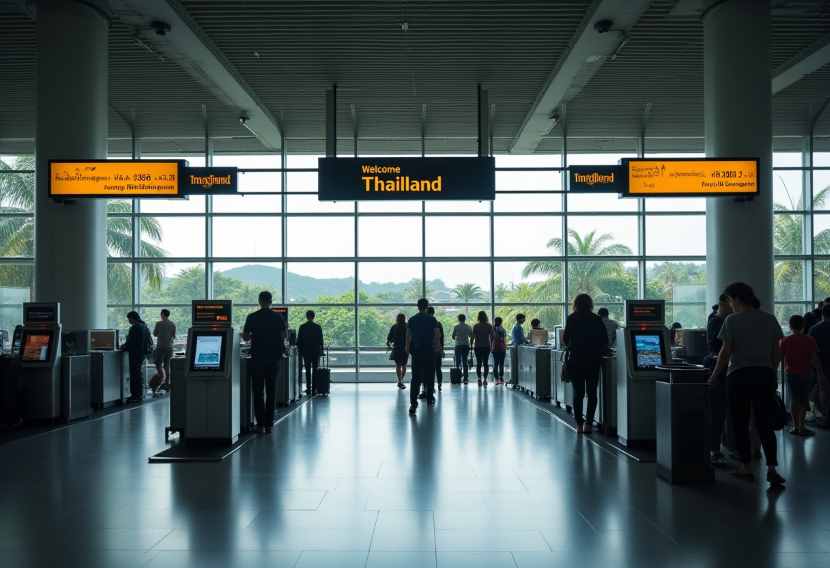≡-Thailand Postpones Tourist Entry Fee Launch, Here’s What You Need To Know More – Viral of Today
<> Viral of Today <>
Home » TOURISM NEWS » Thailand Postpones Tourist Entry Fee Launch, Here’s What You Need To Know More Tuesday, July 15, 2025Introduction: Thailand Offers Breathing Room for TravelersOne of the world’s most visited countries, Thailand, has chosen to delay – yet again – plans for a controversial tourism entry fee, officially called the “Kha Yeap Pan Din (stepping onto Thai soil fee)”. Originally planned for introduction in 2025, this charge is now likely in the second or third quarter of 2026. The move seeks to further assist Thailand as it continues to recover from the worldwide tourism slump due to the COVID-19 crisis.This provision gives international tourists the opportunity to visit Thailand without paying anything additional on top of existing visa and immigration fees, a small financial respite for the time being as the country works to pick up on lost ground in international tourism.“Kha Yeap Pan Din” Explained Briefly: The BackgroundThailand’s proposed tourism arrival fee, enacted in principle by the Thai Cabinet in early 2023, was used as a tool to upgrade the nation’s tourism infrastructure and provide basic insurance to tourists. Under the plan, international tourists would be required to pay 300 baht (approximately $9.25 USD) for those who fly in – and for those who enter the country through any land or sea border, they would be charged 150 baht (about $4.60 USD). The scale of fees is according to the different levels of administration and infrastructure costs for various regimes.Strategic Waiting in View of the Economic and Tourism ChallengesThe Thai government have delayed the fee primarily due to continued economic uncertainty and the fragile nature of global travel recovery. Officials are especially wary of doing anything that would deter would-be visitors at a time when the tourism industry is still getting back up to speed.Sustainable tourism that wants to carefully study the trend of travel, economic recovery, tourists will be focussed on the 25 years behind the peak travel of tourism, the latter half 2025 as a key period. Diligent evaluations of the effect of this fee during this period will serve the authorities to perfect and define in a more precise manner the strategy of the entry fee’s implementation so that it can be promptly adapted to the market and expectations of travelers.Where the Fee Revenue Will GoWhen eventually implemented, the tourism entry fee will have two specific objectives:Infrastructure Enhancement:Proceeds from the fee will go directly to the upkeep, improvement, and expansion of the country’s current suite of top tourism attractions and services. The new facilities, amenities and conservation measures approved will also be welcomed by visitors to popular tourist attractions like historic sites, national parks, beaches and cities.Visitor Insurance Coverage:The entry fee would partially go to give tourists basic insurance. This is intended to increase the safety of visitors by facilitating fast access to emergency services and health care, even in far-off and rural regions. Those types of measures will assist in bolstering confidence among travellers as well as offering essential help when something goes wrong.Implementation Details: A Tiered SystemThe suggested charges in Thailand are intentionally tiered according to the form of entry, taking into account different costs of operations. The $40 one-time charge will be placed on tourists flying into the country, with costs at the airport administration level higher, and on land and sea arrivals, typically regional tourists from neighbouring countries, lower. This graduated approach is necessary to keep access and costs within reach of the many regional visitors, especially from Laos, Cambodia, Myanmar and Malaysia.Impact as a traveler and Fit to existing systemsBy the time the fee takes effect in mid-2026, passengers will probably barely feel it, as they will be seamlessly billed for it along with their airfare. Land or sea entrants may pay at border crossings or add the payment in an online pre-travel registration application. The intention is to keep it clean, clear and easy to pay with minimal fuss or confusion and a comfortable experience when arriving.Following the Global Sustainable Tourism TrendThe introduction of Thailand’s tourism fee is part of a broader global movement towards sustainable and responsible tourism management. There is precedence for such restrictions successfully taking place elsewhere in the world, like in Bhutan, Bali, Indonesia, and Japan, to manage sustainable tourist flows to fund conservation and improve the local infrastructure. Thailand is taking a deliberate approach to learn from international lessons and develop its approach to ensure it strikes the right balance in not only welcoming visitors, but protecting the environment and ensuring the tourism industry supports economic development and social progress.The bigger picture: Building Thailand’s TourismThe delayed entry fee is just one portion of a larger strategic vision intended to generate long-term enhancements within Thailand’s tourism economy. Beyond short-term financial benefit to the state, the fee is a major step toward modernizing our infrastructure, improving visitor safety and creating a more resilient visitor industry when the economy inevitably slows.With Thailand receiving tens of millions of international visitors each year, the authorities are aware they have to find the middle path between immediate economic recovery and sustainable expansion. This proposed fee signals Thailand’s dedication to fostering a rich and diverse tourism industry, one that is both sustainable and just for local communities and visitors.Readiness to Administer: Rolling Out SmoothlyThailand will see a long period of preparation before the eventual implementation of the entry fee. Officials will work out in the technical infrastructure, possible to have teh fee included in the new Thailand Digital Arrival Card (TDAC) system, a digital immigration service introduced recently. Extensive trials and consultation with stakeholders will ensure the roll-out is smooth and efficient, minimising any adverse effects on visitors and tourism.Conclusion: A Prudent Postponement for a Future of BenefitsWochen verabschiedet sich Thailand vom 300 Dollar Touristen Einreisegebühren From mid-2026, which has passed a consideration and test of policy implementation process thoroughness. In the meantime, those ready to travel to Thailand in the next year will benefit from ongoing financial accessibility, and valuable information will be provided to the government to further develop its strategy. In the end, this careful planning is intended to make for a more sustainable and enjoyable tourism landscape in Thailand, so that travellers’ experiences stay as special years down the line as they are today.Tags: Asia, bangkok, Chiang Mai, Kha Yeap Pan Din, Koh Samui, krabi, Krabi Airport, phuket, Phuket Airport, southeast asia, Thai government, Thailand, Thailand tax, thailand travel, Tourism Entry Fee, Travel Updates
This information will surprise you!
See also
- Read until the end to discover everything.
- Important information you need to know.
- Interesting facts and helpful tips.
Conclusion
Did you enjoy the news? Keep following us daily!













